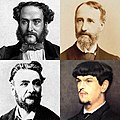Paul Dukas
Paul Abraham Dukas (October 1, 1865 – May 17, 1935)[1] was a French composer and teacher of classical music.
Early life
Paul Dukas was born in Paris to a Jewish father and Catholic mother. He was taught music by Théodore Dubois and Ernest Guiraud at the Conservatoire de Paris, where he became friends with the composer Claude Debussy. He then worked as a music critic and orchestrator.
Early works
Although Dukas wrote a lot of music, he destroyed many of his pieces because he was unhappy with them. Only a few are left. His first important surviving work is the Symphony in C (1896). This is in the style of Beethoven and César Franck. Like Franck's only symphony, Dukas' is in three movements not the usual four: Allegro non troppo, ma con fuoco; Andante espressive e fuoco; Allegro spiritoso.[2]
In 1897 Dukas wrote another work for orchestra, L'apprenti sorcier (English: The Sorcerer's Apprentice) based on Goethe's poem "Der Zauberlehrling". A short version of The Sorcerer's Apprentice was used in the Walt Disney film Fantasia. Dukas's use of rhythm and his skill in writing for orchestras can be seen in both the Symphony in C and The Sorcerer's Apprentice.

Piano works
For the piano, Dukas wrote two complex and difficult works, a Sonata in E-flat minor (1901) and Variations, interlude and finale on a theme of Rameau (1902), again in the style of Beethoven and Franck. The Sonata has not been performed very often, but lately pianists, such as Marc-André Hamelin, have started to add it to their concerts. There are also two smaller works for piano solo.
Opera
The opera Ariane et Barbe-Bleue ("Ariadne and Bluebeard"), which he wrote between 1899 and 1907, has often been compared to Debussy's Pelléas et Mélisande. This is because it is similar in its musical style, and both operas are based on words by Maurice Maeterlinck. Dukas's last big work was the grand oriental ballet La Péri (1912). This is about a man who goes to the Ends of the Earth to find immortality, and finds a mythical Peri, holding The Flower of Immortality.
Because the opening of the ballet is very quiet, Dukas later added a short 'Fanfare pour preceder La Peri' which gave the usually noisy audiences time to settle in their seats before the main opera began.
Teacher
In later life, Dukas became well known as a music teacher, with many famous students including Joaquín Rodrigo, Manuel Ponce, Maurice Duruflé, Xian Xinghai, Olivier Messiaen, Jehan Alain, Carlos Chávez, and David Van Vactor. After Dukas died he was buried in the Père Lachaise cemetery in Paris.
Music[3]
Piano
- Piano Sonata (1900)
- Variations, interlude et finale sur un thème de Rameau (1902)
- Prélude élégiaque sur le nom de Haydn (1906)
- La Plainte, au loin, du Faune (1920)
Orchestra
- Symphony in C Major (1896)
- The Sorcorer's Apprentice, a symphonic scherzo (1897)
- Villanelle for Horn & Orchestra (1906)
- Ariane et Barbe-bleue (1907)
- La Peri (1912)
- Sonnet de Ronsard, for Voice & Piano (1924)
Paul Dukas Media
Dukas's teachers, Georges Mathias (top l.), Théodore Dubois (top r.) and Ernest Guiraud (bottom l.), and Dukas' fellow student Claude Debussy
Costume design for Dukas's La Péri by Léon Bakst, 1922
References
- ↑ "Paul Dukas". Virginia Tech Multimedia Music Dictionary Composer Biographies. Archived from the original on 2009-10-06. Retrieved 2009-12-22.
- ↑ Recording by Netherlands Radio Philharmonic, conducted by Jean Fournet, recorded March 1992
- ↑ "Paul Dukas". Classical Net. 1995. Retrieved 2009-12-22.


